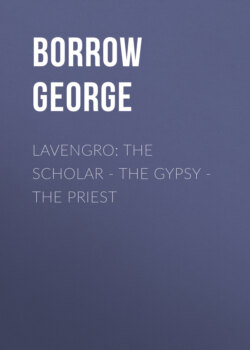Читать книгу Lavengro: the Scholar - the Gypsy - the Priest - Borrow George - Страница 8
На сайте Литреса книга снята с продажи.
VI. Borrow’s Gypsies.
ОглавлениеTable of Contents
To those who knew Borrow, the striking thing about “Lavengro” and “The Romany Rye” is not that there is so much about the gypsies, but that there is comparatively so little, and that he only introduces one family group. Judged from these two books the reader would conclude that he knew nothing whatever of the Lees, the Stanleys, and the most noticeable of all, the Lovells, and yet those who knew him are aware that he was thrown into contact with most of these. But here, as in everything else, Borrow’s eccentric methods can never be foreseen. The most interesting of all the gypsies are the Welsh gypsies. The Welsh variety of the Romany tongue is quite peculiar, and the Romanies of the Principality are superior to all others in these islands in intelligence and in their passion for gorgio respectability. Borrow in “Lavengro” takes the reader to the Welsh border itself, and then turns back, leaving the Welsh Romany undescribed. And in the only part of “Wild Wales” where gypsy life is afterwards glanced at, the gypsies introduced are not Welsh, but English.
The two great successes amongst Borrow’s Romany characters are undoubtedly Mrs. Petulengro’s mother (old Mrs. Herne) and her grandchild Leonora, but these are the two wicked characters of the group. It is impossible to imagine anything better told than the attempt of these two to poison Lavengro: it is drama of the rarest kind. The terrible ironical dialogue over the prostrate and semi-conscious Lavengro, between the child-murderess and the hag-murderess who have poisoned him, is like nothing else in literature. This scene alone should make “Lavengro” immortal. In no other race than the Romany would a child of the elf-like intelligence and unconscious wickedness of Leonora be possible; but also it must be said that in no other race than the Romany would be possible a child like her who is made the subject of my sonnet, “A Gypsy Child’s Christmas,” printed in the “Journal of the Gypsy Lore Society”—a sonnet which renders in verse a real incident recorded by my friend before alluded to:—
Dear Sinfi rose and danced along “The Dells,”
Drawn by the Christmas chimes, and soon she sate
Where, ’neath the snow around the churchyard gate,
The ploughmen slept in bramble-banded cells:
The gorgios passed, half fearing gipsy spells,
While Sinfi, gazing, seemed to meditate;
She laughed for joy, then wept disconsolate:
“De poor dead gorgios cannot hear de bells.”
Within the church the clouds of gorgio-breath
Arose, a steam of lazy praise and prayer,
To Him who weaves the loving Christmas-stair
O’er sorrow and sin and wintry deeps of Death;
But where stood He? Beside our Sinfi there,
Remembering childish tears in Nazareth.
Perhaps Borrow’s pictures of the gypsies, by omitting to depict the Romany woman on her loftier, her tragic side, fail to demonstrate what he well knew to be the Romany’s great racial mark of distinction all over Europe, the enormous superiority of the gypsy women over the gypsy men, not in intelligence merely, but in all the higher human qualities. While it is next to impossible to imagine a gypsy hero, gypsy heroines—women capable of the noblest things—are far from uncommon.
The “Amazonian Sinfi,” alluded to in Dr. Hake’s sonnet, was a heroine of this noble strain, and yet perhaps she was but a type of a certain kind of Romany chi.
It was she of the bantam cock and “the left-hand body blow” alluded to above.
This same gypsy girl also illustrated another side of the variously endowed character of the Romany women, ignored, or almost ignored by Borrow—their passion for music. The daughter of an extremely well-to-do “gryengro,” or dealer in horses, this gypsy girl had travelled over nearly all England, and was familiar with London, where, in the studio of a certain romantic artist, she was in great request as a face-model. But having been brought into close contact with a travelling band of Hungarian gypsy musicians who visited England some years ago, she developed a passion for music that showed her to be a musical genius. The gypsy musicians of Hungary, who are darker than the tented gypsies, are the most intelligent and most widely-travelled of even Hungarian gypsies—indeed, of all the Romany race, and with them Sinfi soon developed into the “Fiddling Sinfi,” who was famous in Wales and also in East Anglia, and the East Midlands. After a while she widened her reputation in a curious way as the only performer on the old Welsh stringed instrument called the “crwth,” or cruth. I told Borrow her story at Gypsy Ring. Having become, through the good nature of an eminent Welsh antiquary, the possessor of a crwth, and having discovered the unique capabilities of that rarely-seen instrument, she soon taught herself to play upon it with extraordinary effect, fascinating her Welsh patrons by the ravishing strains she could draw from it. This obsolete instrument is six-stringed, with two of the strings reaching beyond the key-board, and a bridge placed, not at right angles to the sides of the instrument, but in an oblique direction. Though in some respects inferior to the violin, it is in other respects superior to it. Sinfi’s performances on this remarkable instrument showed her to be a musical genius of a high order.
